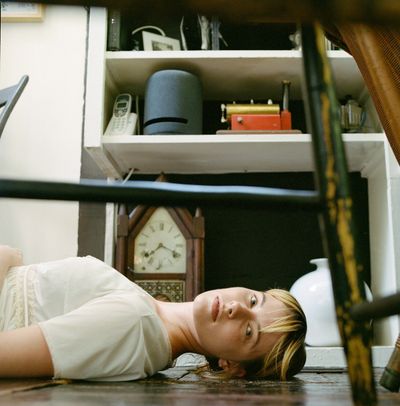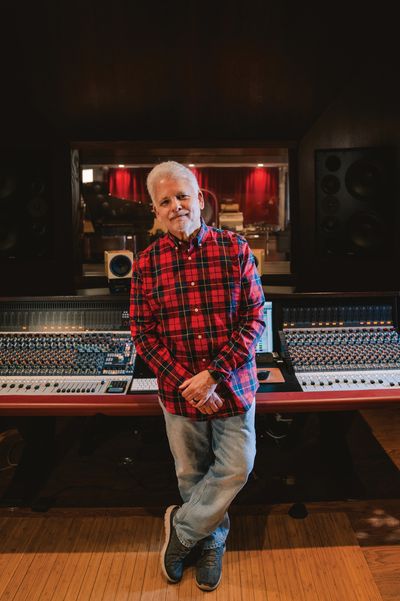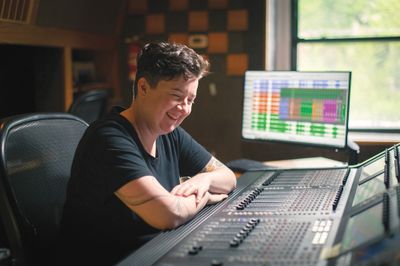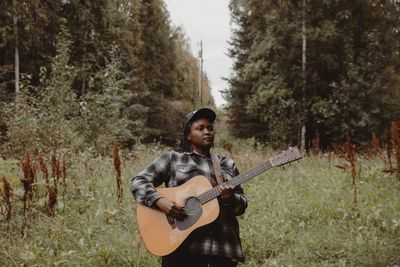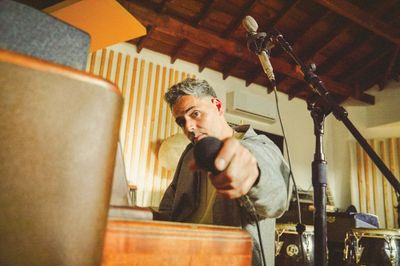Tell me about how Audiotree was started.
Rick Fritz: I think the original idea was that Michael Johnston, the owner, and Adam Thurston, the co-founder, just wanted to do something in music. They thought they were going to be a record label, at first. Then they decided they wanted to help bands build this "tree" of managing, recording, promoting, and tours. They wanted to make a website that a lot of things could come through, like a hub to help people find managers or be managed, recorded, or whatever – a hub for everybody involved to help indie bands. Then the brainstorming started. They came to our studio downtown – not this one, but a previous studio we were in – and they were kicking around the idea of recording, or doing some kind of streaming. It evolved from that. I was like, "I used to do live sound over the airwaves for WXRT [a radio station in town]." Famous bands would come in, and we'd do on-air broadcasts. It was just radio though – not TV or video. I threw that idea out there to Michael and Adam. Like everything, you just try it. The first time we did, it was kind of a mess.
How many years ago was that?
RF: I met Michael and Adam in July of 2010.
Did they seek you out because you were already on the radio?
RF: No. They just happened to show up to talk business with Ira Antelis, who is part of Jira, the music production company here. When they came in, Michael and Adam were sitting in the back of the room talking while I was doing a mix. Then Ira said to me, "Hey, you should meet these guys." We started having conversations about it.
You had experience doing radio broadcast, but what about video production?
RF: I studied video more than audio at the beginning of my life. When I used to work for a record label, video people were always coming around in the '90s. I'd work on album projects, and people were always saying we should document this or that. In the back of my mind, I was thinking, "This is silly. We're recording bands, but we don't have anybody filming or taking pictures." Somehow that idea got thrown out there to do this. Jon LeClerc sought out videographers from Columbia College. Three or four bands were in the studio right away; we were bumping each other around, and trying to figure it out. They were documenting it – making the videos. We weren't broadcasting the video, at that point. We were just doing the audio through a little portal in the website.
When did you start doing the video broadcast?
RF: How it started was, we were broadcasting through this webcast portal using Adobe Live for the audio. We're encoding it, and I'm looking at this stupid little picture on the window. I thought, "That's a video picture. Where is that coming from, anyways? What if we just plugged in a USB camera? Would something happen?" I went and bought a USB camera, plugged it in, and the video showed up in that window. I was like, "That's crazy!" We put one USB camera out there, and that's how it started. Then people thought we could plug in more and switch them. Ustream started making a producer program, and we got more USB cameras and started switching. I instigated the broadcasting side of it with my laptop and USB cameras. Then everyone started getting into it. "Oh, we can type little bumpers and overlays." We just kept pushing with, "Hey, when are we going to tether the cameras? How can we split them off?" Michael suggested that we put GoPro cameras on them – all these ideas and thoughts. Eventually other websites were doing nice broadcasts. "Why can't we do that?" My friend, Bill Allan, he does all this TriCaster [live video switcher] work – he was doing it for Comcast, and teaches it in school. I was like, "Bill, how can we do this?" He said, "Oh, it's this TriCaster thing," – which was the same thing Adam said we needed to get. We got it, plugged the cameras in, because the cameras have the output, and started doing it that way.
Rick, you told me earlier that you attended Columbia College here in Chicago. Were you in an audio engineering program?
RF: It was recording. They had an engineering degree for a couple of years. I didn't complete it because it was ridiculous to me. I became a chief engineer at our studio downtown in the late '80s. It happened so fast for me. I went to Los Angeles right after high school to go to the Musician's Institute. I ran out of money, came back to Chicago, and met an old producer of a band I was in. He said, "Hey, we're building a new studio downtown, and we're looking for people to help build it." I was 18 or 19 years old, at that point, so I helped carry drywall and build the studio. The crazy thing was that it was a Tom Hidley-designed studio. Then we got to working. The first session in there, I was so overwhelmed. It had a Neve 8068 board, a pair of Studer A 800 tape machines, a Lexicon 480L – a brand new thing back then, and old plate [reverbs]. There was a great microphone collection, because it was a collective of a lot of engineers in town. Because of that room, and the sound of that room, it made me sound good. I got sucked into it, and we got an SSL for another room. The studio space exploded. I think the first session I did by myself was in spring of '87 – as just like, "Hey, you can go in the B Room and mess around." I had engineered in little studios as a kid doing bands or whatever, but I didn't know what I was doing. I learned fast. It was like working in L.A. at a major studio. Famous people came in every day.
You went from someone who was helping build a studio, to chief engineer at River North Studios?
RF: Within a year, which is insane. I never left the studio. They would have to kick me out. I had an overwhelming amount of work, and training, and had to rise up. I learned every time someone came through there and did something that blew my mind. I'd say, "Well, I'm going to put that in my little bag of tricks."
How long did you last at that studio?
RF: We closed down the studio in '97. It turned into a record label and all these other things. It became Platinum Entertainment and traded on the NASDAQ as a record company. We got funded by A&M and Polygram. When it ended, I was doing a bunch of records with Brian Wilson there. We became more of a private studio, at that point. We were a public studio at first, with eight rooms when we were going crazy. We started using the main room just for our own projects – doing an album with Brian Wilson and The Beach Boys. Brian was like, "Hey, I think I want to live in Chicago." At the time, our rent from the building was so high. We said, "Why don't we just build a studio out in the suburbs?"
This was in '97?
RF: Yeah. Brian had bought a brand new, just-built house out in the suburbs. I was like, "You can't build a studio in this basement. The ceiling's only eight feet tall!" They bulldozed through the house – a brand new million-dollar home – and dug the whole thing out. We put in this giant SSL and all this gear.
Who designed the rooms?
RF: My former boss [Joe Thomas] and myself. We had already done about a dozen rooms, at that point. I got sick of going to St. Charles, Illinois, where it was. Brian wasn't a prolific writer or worker at that point in his life, so there would be long stints of nothing going on at that space. I started working in Nashville then, because I had a lot of great relationships down there.
You lived in Nashville?
RF: I lived here in Chicago, and also drove to Nashville weekly and started doing records down there with a producer named Barry Beckett. The stint of going to Nashville was only about a year and a half. I worked with LeAnn Rimes, when she had just been signed by Chuck Howard, and we cut that acoustic version of "Blue." Barry had me slated to do Kenny Chesney's first record, but I wound up going to New York to work for Ira, with a kid that got signed by Tommy Mottola.
What was it like to be working in New York City at that time?
RF: The sessions in New York – we had unlimited funds. This was '98 or so. I worked with Destiny's Child, Usher, and this kid JoJo. They were all unsigned, or they had just been signed. I was in New York for only three months, and then I ended up back here.
Why did you decide to move back to Chicago?
RF: Family, my wife, and everything. I had a house here. To be honest, I just knew so many people here, and the work was easy, friendly, and convenient.
Did you build another studio when you came back?
RF: Ira's always had studios, and I've always worked for other people at other studios. I've always been independent, ever since we got rid of our studio that we had with Brian Wilson. I decided I wanted to be an independent engineer and own all the equipment, but not have a space. I foresaw that studio ownership would be an imploding thing that would be disappearing. I always thought you could record anywhere. I built a studio in my house and could record – full-blown, isolated, and all that.
After you got back from New York, you built a studio in your house?
RF: ...and I hated it. I'd have bands come over; they'd be floating around in my house, out in my yard, and through all my stuff. I'd be working, and all of a sudden I'd go from seeing the whole band in the room, to wondering where some of them went. They'd be everywhere. I didn't have the home and studio separated enough.
Tell me about the history of the studio that we're in now.
RF: This used to be called Engine Studios. It was Brad Wood's place [Tape Op #99]. It's a great space. It's one of the few studios in town that I thought felt like a Nashville or an L.A. room, where there's a density to the space. You walk in, and you just feel the thickness of the walls; the low-end comes back tight. This room here has a lot of midrange color, and you can hear it when we bring it up.
When you do an Audiotree broadcast, who's involved in the production?
RF: Me and Patrick usually do all the audio – setting up, recording, mixing, and mastering. We usually have four videographers who split duties on setup. One or two will be doing the lighting, others will be out getting the cameras set up and formatted, and then they go and shoot. Then there's Keelan Dellisse, our Technical Director. He sits here in the control room, runs all the TriCaster switching, and talks to the videographers in their ears to get everything looking right.
What's happening as the band arrives?
PD: Unless it's a large band, we'll always set a two-hour window, from load-in time to live time. If it's a 2 o'clock broadcast, and we want the band here by noon, we'll be here by 11. Ideally, the band gets set up in a half hour or less, and then we try to jump right into soundcheck – get everybody checked and comfortable. Rick has impressed upon me the importance of the philosophical side of getting bands in here, and getting them comfortable and excited – putting them in a positive, creative space.
What's involved in getting the artists in that creative mood?
RF: Well, you're just overwhelmingly nice to everybody. We love doing this. There are so many people who don't care about bands in the touring food chain. Most bands come in here and are like, "Is it okay if I stand here? Is it okay if I go to the washroom?" A lot of them are very worn down by sound engineers, managers, or whomever. When they come in here, you want them to feel all right. They're so beaten up on the road. Most bands that we deal with aren't established; they aren't massive touring bands that have all their things and assistants.
Do you find that some of the bands are nervous when they come in?
RF: Yeah. I have to "un-nervous" them. I have to throw myself out there like I'm a blithering idiot half the time. As soon as I meet somebody on the street or wherever, I read where they're at. I understand the psychological impact of being overwhelmed or nervous. There are even times when two minutes before we're going to go live, and these cameras come up from nowhere, they're like... [makes nervous face]. And then I'm out there. I'll slay the host or myself in front of them, and just do anything to get them to laugh and be happy. Patrick's seen it, obviously. I say the stupidest things in the universe.
PD: He really does.
Let's talk about setting up and running the sound check. What happens?
PD: Ideally we'll come in and introduce ourselves to the band. Basically everything will be pretty much mic'd up, assuming they're using our drums, piano, and amps. If not, then we'll have mics loosely positioned. The videographers have everything mapped out for what they want the room to look like.
So, the videographers know ahead of time what the band setup is going to be like?
RF: Yeah, we all do. We get a rider from them as part of the whole agreement.
PD: Yeah, everyone's positioned, and we're pretty much set up. We've set up the console, Pro Tools, and all the mics. Everything will be mostly cabled up. We'll let the bands get comfortable and get them anything they need as far as power, stands, and backline. Once they're in position and locked down, ready to go, then we'll do final placements on the mics. Then we'll hop into the control room and start sound check.
Given that you have two hours to set up, and you're going to be broadcasting live, my assumption is that you've got certain mics that are going to work, and specific signal chains that you rely on.
PD: For kick, we've got a new Telefunken M82, which we like a lot. It's like an AKG D 112.
RF: Sort of a fat, Neumann U47fet kind of sound.
PD: That through a Neve 1073 channel. Sometimes we do a Chandler TG1 compressor on it. Sometimes we just use the SSL channel compressor on the board. Then, from there, it's into Pro Tools. Snare is a [Shure] SM57 through a 1073. Again, sometimes we'll put a TG1; sometimes just the SSL compressor. AKG C 414s on toms, which is something that Rick introduced me to, and I think is cool... unless you smash them up too bad.
RF: There are definitely a few that have been dented, but it's okay. It's just the windscreen. 414s always sound open to me. Dynamics just sound like shit, compared to condensers on toms. I put 414s on the drums when I was in Nashville. The drummers were like, "Man, you care about the toms."
What about overheads?
RF: Here's the joke. This one engineer came through and he used AKG C 460s on all the cymbals. It was a jazz thing, with Omar Hakim on drums. Man, the cymbals sounded so clean and clear. I immediately latched onto that idea, with the pencil condensers for close mic'ing the cymbals, and using additional room mics for the depth. I kept that going forward. I read a story 20 years ago that Bob Clearmountain [Tape Op #84] did the same thing.
But you're still using 460s?
RF: Yeah, they're just "spotlights," in this scenario. I've used all different mics. I did a couple records with Eddie Kramer [Tape Op #24] and John Mellencamp. Mellencamp wanted to do a sound like Physical Graffiti from Led Zeppelin. We got a bunch of U 47s and put them in the classic overhead configuration. That sounded cool too, but it definitely sounded like that, as opposed to the clean bell kind of sound. I've done different scenarios like that for sure.
What about guitars?
PD: SM57s.
RF: Royer ribbons, if we're feeling it's too bright.
PD: Ninety-five percent of the time, it's SM57s. But if it's just an electric guitar on its own, we feel like we either want a little bit wider image or a little more nuance. So we'll put an SM57 and a Royer on the cabinet and blend the two mics.
On separate channels?
RF: Separate channels, yeah; we just move them around to make a wider image or add some Fulltone Tri Stereo Chorus on it to spread it out a little bit. It always sounds terrible to me when it's just a single guitar player stacked on top of everything else. There needs to be a little separation.
What about bass?
RF: Bass, we do always a DI, and then mic whatever amp is being used. The DI is either ours or comes out of a pedalboard.
PD: We've had some cool DI sounds come through here. Aguilar is a cool brand. The olive-colored MXR M81 is a bass preamp pedal we've seen three or four times now. Ashdown – their DI sounds great. I like a clean DI signal that you can blend with... what's the 47 version we have?
RF: We have a Soundelux IFET7. We have several U 47 fets, but I just choose not to put them out. There are so many people in this room setting up, and moving around, that I've had too many mics get knocked around. You'll see it laying on the floor with a dent in it, and that's gonna cost $300 to fix. The mics we use are affordable, not irreplaceable.
PD: I feel like we're kind of the anti-gearheads, in a way. We love gear, and we love trying out new gear, but those Audiotree tutorial videos we did came about because we had a lot of people asking how we get our particular sound. Like any engineering, there's no magic. There's no trick. It's just finding what works for the situation, knowing how to work it to your advantage, and just going for it.
The concept of using the vocal and talk mics as the room mics – the bleed that's in those mics becomes the glue that puts it all together. Did you guys discover that accidentally? Or did you know ahead of time?
RF: That was a byproduct of that initial setup, because it was there. After I started to get into EQ'ing and using multiband compression on the vocals, the room started to come through and help everything. You could hear guitar, but it didn't sound close-mic'd – just bleed from the space. All the usual instincts – isolate it, gate it, throw a blanket over everything, put the amps in the hallway – all those instincts were there in the first probably half a dozen sessions. I think we were doing the band Company of Thieves. I realized, "Wow, all these bleeding mics, if you just leave them up at a certain level or ride them, you could make some cool shit." It just clicked in my head. It's what makes the difference with the thing that I was entranced about with the original studio, where there was such great bleed sound. You have to manage it while you're recording, and you have to really listen to the end result. Even when we're sound checking, I rarely solo anything discretely. Instead, it's just how it fits. "Is it in its position, sonically fitting into the place it belongs?" I don't think doing the discrete thing really helps me anymore. I want to hear what the whole package sounds like, and then make observations. "Does it seem like there's a little too much going on? Is it too fuzzy? Are we running the vocals a little too hot?" If I hear something leaking, I'll go, "Oh, it's the bass amp." Or the background vocal. You find it and just do a couple quick adjustments, and it comes together fast.
What about for a band that is primarily acoustic instruments? Is there a difference in how you approach the session?
RF: We really want the acoustic band to sound good and not all DI. I think if we can capture the performance with mics, then it's better. We definitely have bent some of the things. The other day there was a guy playing acoustic guitar, and it sounded more DI'd than mic'd. Maybe a year ago we would have fought to put a spot mic on it. The artist said, "I'm going to move around a lot." I said, "The mix just sounds better." Even if you have 10% of that feathered in.
Do you set up separate room mics, or do you rely on the vocal mics?
RF: Room mics always, with acoustic bands. I think lately, unless no channels are left on the board, we will always put a pair of room mics on top.
What do you typically use for room mics?
RF: A pair of Royer R-122 ribbons. We have a couple sets of different mics. If we're using the Royers for something else, then we'll grab another selection, but we've been leaning on those for room mics most of the time. They work in this room. We have to EQ them a little bit.
Does every mic typically have some processing on it?
RF: We have enough outboard gear that you can pretty much make it sound pretty darn good, between the Neve, SSL, and all that. Outside the box, for reverbs, we either use the plate down the hall or the Lexicon 480L. And then for slaps, the Fulltone Tri Stereo Chorus [That 80's Rack Chorus]. I like that on vocals and instruments to widen out the sound when it's too discrete. Honestly, we have a lot of processing going on in Pro Tools. For example, we use multiband compression on vocals for the plosives. We also do some rolling off. There's a lot of processing going on before the mix hits the air. You've got compression, all the colors hitting the rack, and the upward compressors in the SSL. And then in-the-box, we'll have things, like Patrick will put on some notch filters if there's something gross poking out.
How many channels do you have set up for, let's say a band that has two guitars, two singers, a bass player, and a drum kit. What would you do?
PD: 20-ish channels. We really oversimplify it. A typical four-piece band looks like kick, snare top, rack, floor, overheads, hi-hat, bass DI, bass mic, a mic on each guitar, and a vocal mic for everybody in the band. And then we have our host mic and the audience clap mic.
Patrick, as the person who is involved in some of Audiotree's business activities, how do you find that the technology landscape today affects your work?
PD: I'd say it's probably just a matter of trying to find the creative balance in the business side of it. A lot of the opposition that we get from labels when we present them with our agreement, and say we want to distribute this everywhere is, "Well, it's going to be in direct competition with our official release, and we've already spent $30,000 on recording and promoting it." Rather than get into a conversation about the legalese, or what sort of waivers we need to get around an exclusive recording contract, I want to make it seem like, "Look, this is something that will bolster your release. This is essentially a live teaser." We've always talked about how Audiotree is the midpoint between a live show and an album. It's the best of both worlds.
RF: One of the goals is to be a service for the label. The bands are great. They want to come and do this. I remember, as a kid, my understanding of the business was that record labels used to have the studios and the producers. You'd get signed by Capitol Records, and you'd go and work at Capitol Records, and you would have a Capitol Records producer and engineer, and all that. I feel like record labels nowadays outsource everything. In my mind, it's like, "Why can't we start doing that too for labels?" They can test a band, record them, and see if they can perform live and under pressure.
Have you presented that model to record labels?
RF: You can see how they look and feel on a format that's now established. If you inject them into the thing, you can judge them, I guess, or rate them, or whatever – see what they have to offer and how they interact. That's the model of the future. It's an intimidating situation, but what do you think in five or ten years? Bands might be playing live over the internet to the world, instead of touring. It's just like, "Well, we're going to go into our virtual performance concert thing" – and boom.
PD: We haven't presented that idea explicitly, but a lot of what I've talked about with some labels is, if they have an album coming out in three months, I'll say, "We can have this finished and good to go in two or three weeks. You guys put your promotional muscle behind it, and then you guys have a teaser for the album. The fans will also have some idea of what to expect if they go see the band live." Streaming is how people get music nowadays. I'm always going to buy records. I prefer to pay for music and have it, but the biggest part of the population is going to move towards streaming, because that's the easiest, and that's what's being pushed.
RF: I think, in general, what it's doing for a lot of the bands is creating an awareness for them. Doing an Audiotree session is a great promotional thing. If they're on tour, they go to the next city, and however many more people show up for their show. It was originally designed to help those bands. Michael, who started the company – his original idea was to help build an awareness for these bands. He always kept saying, "When I was growing up, there wasn't anywhere to find these bands in Kalamazoo." Then, when he moved here to Chicago, he wanted to be involved in that community. Adam worked at Lincoln Hall and Schubas Tavern. It's just that whole thing of wanting to be submersed, as well as figuring out a way to make that "tree" with all the branches to help different people – to be a hub for managers, and labels, and artists. It's been a lot of twisting and turning, and ups and downs, dealing with people and bands, and trying to figure out how to make it all work. But this is the one thing that's stuck. Creating this technology, and developing it, is definitely creating a brand for them. We've had repeat bands come in, or we go out and people will be like, "Hey, remember me? I was in this band; that session was the greatest thing in the world and helped our band immensely." That's what it's there for – to do that. If you keep building that brand, eventually it'll be big enough.
